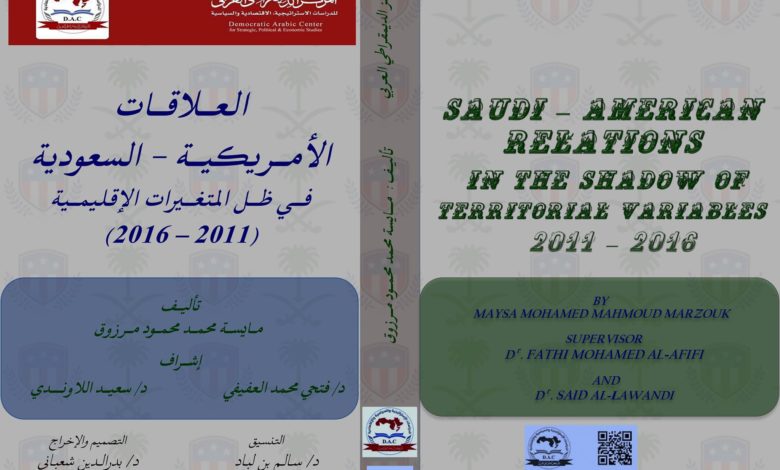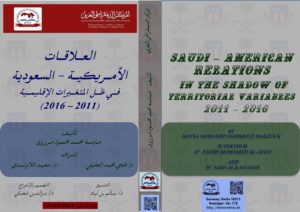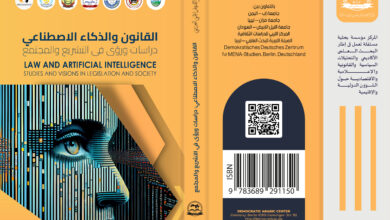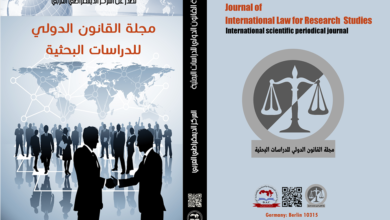العلاقات الأمريكية – السعودية في ظل المتغيرات الإقليمية (2011 – 2016م)
Saudi-american relations in the shadow of territorial variables

المؤلف : أ. مايسة محمد محمود مرزوق
تحميل نسخة pdf –
العلاقات الأمريكية – السعودية في ظل المتغيرات الإقليمية 2011 – 2016م
الطبعة الأولى “2020″ – كتاب:- العلاقات الأمريكية – السعودية في ظل المتغيرات الإقليمية (2011 – 2016م)
جميع حقوق الطبع محفوظة: للمركز الديمقراطي العربي ولا يسمح بإعادة إصدار هذا الكتاب أو اي جزء منه أو تخزينه في نطاق إستعادة المعلومات أو نقله بأي شكل من الأشكال، دون إذن مسبق خطي من الناشر .
مقدمة :
تسعي الدراسة الي تناول العلاقات الامريكية – السعودية خلال الفترة من (2011- 2016 ) وتأثير عدد من المتغيرات الاقليمية علي العلاقات بين البلدين من خلال استعراض أهم التحديات التي شهدتها المنطقة بدءا من اندلاع ثورات الربيع العربي ومرورا بالأزمة السورية وتوقيع الاتفاق النووي الايراني وكيف تعاملت كلا من البلدين مع الاحداث.
فعلي الرغم من ان العلاقات الامريكية – السعودية توصف دائما ” بالاستراتيجية العميقة ” فإن المتغيرات الاقليمية منذ عام 2011 وحتي عام 2016 تؤكد ان تلك العلاقات تجتاز مرحلة دقيقة من تاريخها , وان هوة الخلافات تتسع بين الجانبين نتيجة اختلاف وتباين مواقف الدولتين تجاه عدد من القضايا والازمات الاقليمية. لقد كان الحادي عشر من سبتمبر 2001الحدث الاكثر تدهورا في تاريخ العلاقات الامريكية – السعودية , الا انه مع عام 2011 وفي ظل التحولات السياسية والاحداث الغير مسبوقة والتي شهدتها المنطقة العربية من اندلاع ثورات جماهيرية مطالبة بالإصلاحات الديمقراطية في الوطن العربي …. هذه الاحداث التي لم تكن متوقعه وبدأت في صورة انتفاضات شعبية واسعة لمواجهة الفساد ومحاربة الفقر والغلاء والمطالبة بالحرية والكرامة والعدالة الاجتماعية وصولا الي المطالبة بأسقاط انظمة وصفت بالفساد والاستبداد.
وتأتي أهمية هذه الثورات ليس فقط في اطارها الاحتجاجي الداخلي بل لما انتجته من تداعيات علي الخريطة الجيوسياسية للمنطقة وعلي توازنات القوي الاقليمية والعالمية , وما نتج عن ذلك من فوضي عارمة وتدهور للأوضاع الامنية وأزمات الاستقرار , وفي ظل حاله السيولة التي مرت بها المنطقة اثر موجات الحراك الاحتجاجية الشعبية منذ عام 2011 والتي افرزت سقوط أنظمة تقليدية وتشكلت أنظمة جديدة(كما الحال في مصر, تونس ) تسعي الدراسة للوقوف علي تأثير هذه الاحداث علي العلاقات الامريكية – السعودية , ففي بعض الملفات (كالحالة البحرينية واليمنية) تشابكت و تقاطعت المصالح الامريكية السعودية وفي ملفات اخري (كالملف المصري والملف السوري ) كان هناك تناقضا عميقا في المواقف وتباين في المصالح الامر الذي افرز درجة عالية من التوتر وصلت الي درجة التأزم في بعض الاوقات ووصفها الجانب السعودي بالتخلي الامريكي عن حلفاءه والشريك السعودي في المنطقة .
لقد تزامنت هذه الاحداث العاصفة منذ عام 2011 مع رغبة ادارة الرئيس اوباما في انسحاب طوعي تدريجي من المنطقة وتبدل في اولوياتها وتراجع في الاهتمام بمنطقة الشرق الاوسط وقضاياها وتحول نحو الاهتمام بمنطقة اسيا والمحيط الهادي … مما اثر علي حسابات القوي الفاعلة الاقليمية وفي مقدمتها المملكة العربية السعودية .
أيضا ,مع الاعلان عن توقيع الاتفاق النووي الايراني في يوليو 2015 والتقارب الامريكي – الايراني زادت حدة التوتر بين البلدين وبرز القلق السعودي في ظل سعي ايران لبسط نفوذها في بؤر الصراع في المنطقة (العراق , سوريا , اليمن ) الامر الذي يمثل تهديدا لأمن المملكة والاستقرار الاقليمي . وعلي صعيد البرنامج النووي الايراني، تزداد مخاوف المملكة بشان البرنامج النووي وقيام ايران باستهداف اي دولة في منطقة الخليج العربي وحول الموقف السعودي من البرنامج النووي الايراني أعلنت السعودية عدم قلقها منه مادام ملتزما بجوانبه السلمية، كما أعلنت رفضها لاستخدام القوة العسكرية ضد ايران، لكنها تتوجس من امتلاك ايران للمفاعلات النووية وتطويرها الي قدرات نووية عسكرية ودعت ايران الي “الالتزام بالتعهدات الدولية والمواثيق ذات الصلة بالوكالة الدولية للطاقة الذرية” مع ضرورة اخضاع المنشآت النووية الايرانية للتفتيش والرقابة الدوليين تحقيقا لمبدأ الشفافية.
لقد ادي الزخم في التحولات الاقليمية وتصاعد التهديدات الامنية الي احداث تغيرات تتفاوت في كثافتها في توجهات وأدوات السياسة الخارجية السعودية وصولا الي استخدام أداة التدخل العسكري وسياسة الردع الاستباقي , كما حدث في “عاصفة الحزم ” في اليمن 2015 .
من ناحية اخري ,حدث تحول في السياسة الخارجية السعودية من سياسة الظل الهادئة والاعتماد علي مظلة الحماية الامنية الامريكية الي سياسة المواجهة والمبادرة والاعتماد علي الذات للدفاع عن أمنها القومي ومصالحها الاستراتيجية في ظل سياسة الانكفاء الامريكي عن التدخل المباشر في قضايا المنطقة ومدفوعا بخيبات متكررة من الحليف الامريكي في عهد ادارة اوباما .
اضف الي ذلك, انتهجت المملكة سياسة تتسم بقدر أكبر من المرونة وتنويع الحلفاء علي المستوي الدولي وخاصة مع الدول الكبرى ( روسيا& الصين ) نموذجا والتي باتت تلعب دوراً رئيسياً في بعض القضايا الاقليمية ( كالأزمة السورية ) والاعتماد علي التحالفات الوظيفية التي تقوم علي التوافق في قضية واحدة مع دول اخري لتحقيق مصالح مشتركة بغض النظر عن تنافر المصالح في قضايا اخري .
وتخلص الدراسة, الي ان بالرغم من الخلافات وتباين المواقف الامريكية والسعودية تجاه عدد من القضايا والازمات الاقليمية خلال فترة الدراسة (2011- 2016 ) وسعي المملكة الي تنويع الحلفاء علي المستوي الدولي الا ان هذا لا يعني فك الشراكة بين الجانبين الامريكي والسعودي أو استبدال صديق قديم بأخر جديد , حيث استطاع البلدين تجاوز أزمات عميقة وأن تاريخية العلاقات بين البلدين كفيلة بتجاوز الخلافات او اية تغييرات في توجهات ادارة رئيس ما ,كما ان استمرارية العلاقات يحكمها مصالح متبادلة علي الجانب الاقتصادي والتعاون العسكري والامني وصفقات الاسلحة الضخمة والاستثمارات الهائلة للسعودية في الولايات المتحدة تحول دون انفكاكها وان كانت العلاقات تتبلور في شكل جديد لا يقوم علي التبعية او اعتماد كلي علي مظلة الحماية الامنية الامريكية بل هي أقرب الي الاعتماد المتبادل وتبادل المنافع والمصالح المشتركة وعلاقات أمنية ذات بعد استراتيجي .
لقد بات واضحا ان فترة الدراسة من عام(2011 – 2016 ) شهدت عملية انتقال للتحالف الامريكي – السعودي الي مرحلة استراتيجية جديدة , تختلف في معطياتها ونتائجها عن تحالف “النفط مقابل الامن ” الذي جري في عام 1945 .
Abstract :
The study examined the most important regional changes and their impact on the US-Saudi relations during the period (2011-2016), by reviewing the most important challenges in the region, from the outbreak of the Arab Spring revolutions through the Syrian crisis and the signing of the Iranian nuclear agreement and how both countries dealt with events
. Although the US-Saudi relationship is always described as a “deep strategy,” the regional changes from 2011 to 2016 confirm that these relations are passing through a delicate period of their history, and that the differences between the two sides widen due to differences of positions of the two countries on a number of regional issues and crises. The 11th of September 2001 was the most devastating event in the history of US-Saudi relations, with the advent of 2011, and in light of the political transformations and unprecedented events witnessed by the Arab region in the wake of mass revolutions demanding democratic reforms in the Arab world. . . . These events, which were not expected and started in the form of popular uprisings to confront corruption and fight against poverty and high price and demand for freedom and dignity and social justice to demand the overthrow of regimes described as corrupted and tyrannical .
The importance of these revolutions comes not only within its internal protest framework but also because of its repercussions on the geopolitical map of the region and The balance of regional and global powers, and the resulting chaos and the deterioration of security conditions and stability crises, and in light of the liquidity experienced by the region following the waves of popular protest movement since 2011, which resulted in the fall of the regimes (Such as in Egypt and Tunisia), the study seeks to determine the impact of these events on US-Saudi relations. In some cases (such as the Bahraini and Yemeni cases), US and Saudi interests were intertwined and in other files (such as the Egyptian file and the Syrian file) there was a deep contradiction in attitudes and divergence of interests, which created a high degree of tension and reached the degree of crisis at times and described by the Saudi side as US abandonment of its allies and Saudi partner in the region.
These stormy events have coincided since 2011 with the Obama administration’s desire for a gradual voluntary withdrawal from the region, shifting priorities, declining interest in the Middle East and its issues, and shifting attention to the Asia-Pacific region. . . Which affected the calculations of the regional powers, particularly Saudi Arabia.
With the announcement of the signing of the Iranian nuclear agreement in July 2015 and the US-Iranian rapprochement, tension between the two countries has increased and Saudi concern has emerged as Iran seeks to extend its influence in the hotbeds of conflict in the region (Iraq, Syria, Yemen), posing a threat to the kingdom’s security and the regional stability. On the level of Iran’s nuclear program, the kingdom’s fears about the nuclear program, Iran’s targeting of any country in the Gulf region, and the Saudi position on Iran’s nuclear program have been expressed by Saudi Arabia, as long as it is committed to its peaceful aspects and declared its refusal to use military force against Iran. But is concerned about Iran’s possession of nuclear reactors and development of military nuclear capabilities and called on Iran to “abide by the international commitments and conventions related to the International Atomic Energy Agency program, with the need to subject the Iranian nuclear facilities to international inspection and control to achieve the principle of transparency.
The momentum in regional transformations and the creation of security threats has led to a change in Saudi foreign policy attitudes and tools to the use of military intervention and preemptive deterrence, as was the case in Yemen’s “Decisive Storm” 2015.
On the other hand, there has been a shift in Saudi foreign policy from the policy of the shadow of calm and reliance on the umbrella of US security protection to the policy of confrontation and initiative and self-reliance to defend its national security and strategic interests under the policy of the US withdrawal from direct intervention in the issues of the region and driven by repeated disappointments of the American ally Under the Obama administration.
In addition to this, the Kingdom has adopted a more flexible policy and diversified allies at the international level, especially with the major countries (Russia and China), which are playing a major role in some regional issues (such as the Syrian crisis) and relying on functional alliances based on consensus in one case With other countries to achieve common interests regardless of the conflict of interests in other cases.
The study concludes that despite differences and divergent attitudes of the US and Saudi Arabia towards a number of regional issues and crises during the study period (2011-2016) The Kingdom seeks to diversify allies at the international level, but this does not mean breaking the partnership between the US and Saudi sides or replacing an old friend with a new one. The two countries have managed to overcome deep crises and the historic relations between the two countries can overcome differences or any changes in the direction of the administration of any president, , And the continuity of relations governed by mutual interests on the economic side and military and security cooperation and huge arms deals and massive investments of Saudi Arabia in the United States prevent the break-up, although relations crystallize in a new form does not depend on dependency or dependence on the umbrella of US security protection, but is closer to mutual dependence and mutual benefits and interests and security relations with a strategic dimension.
It is clear that the period of study (2011-2016) witnessed the transition of the US-Saudi alliance to a new strategic stage that differs in its results from the oil-for-security alliance that took place in 1945
- الناشر: المركز الديمقراطي العربي للدراسات الإستراتيجية والسياسية والاقتصادية





